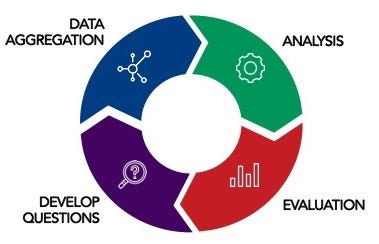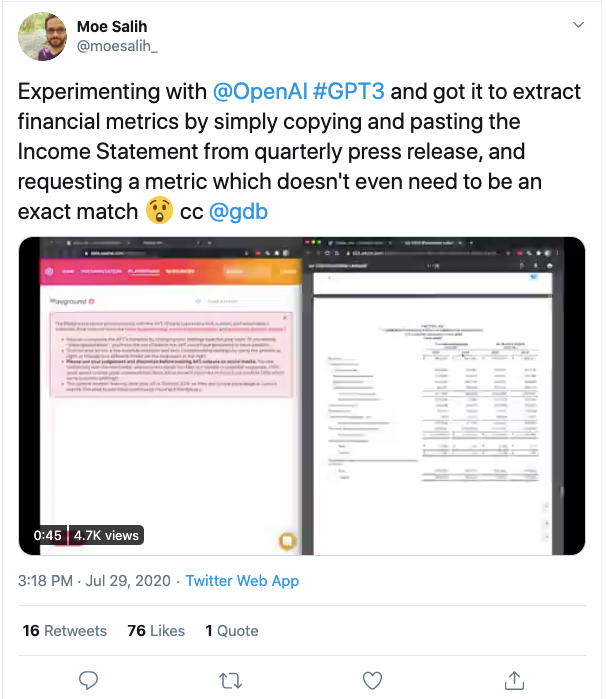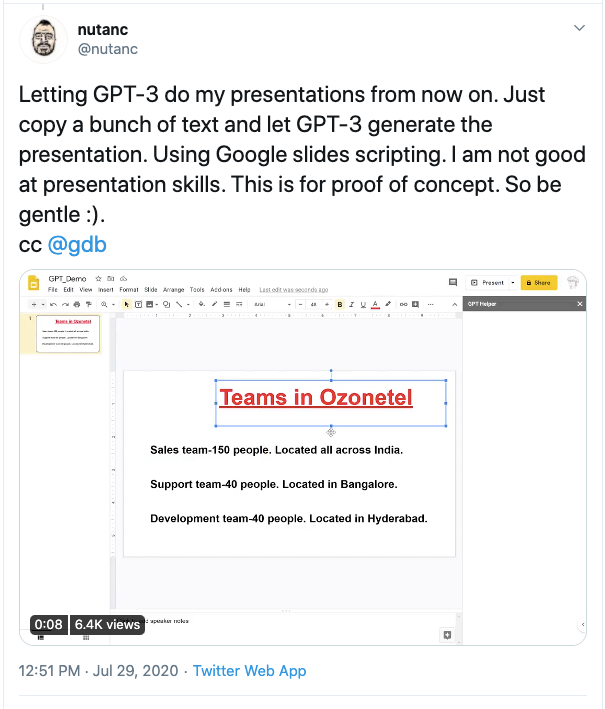Machine Learning and GPT-3: Applications for Private Equity
- August 11, 2020

At Trident, a large part of our strategy to support independent sponsors and invest in small businesses is to apply state of the art technology to the private equity investment process. We use a combination of proprietary and third-party software to make the due diligence, communication, and investment process more efficient. Look out for future posts on more detail and perspectives on how we are iterating on and developing our systems.
One area of interest at Trident is the application of artificial intelligence and machine learning (AI/ML) to various aspects of the investment process. Applications of AI/ML to public market investing has been well documented, but there is far less discussion on its use in private markets. There are a variety of reasons for this, but a major one is access to data. ML systems are best applied to situations where there are repeatable patterns and where enough data is available to uncover those patterns. Although the existence of repeatable patterns is less certain, there is definitely more data available for public market investing than private market investing.
Applying ML to the PE Process
The lack of large financial datasets in private equity may be a barrier for the application of ML to the investing process, but there are many other areas of the due diligence process where it can be applied. One way to think of the private equity due diligence process is as an iterative stepwise process. The investment team develops questions that need to be answered about a specific opportunity. To answer those questions the team then aggregates various data, analyses that data, and then evaluates it. This often leads to a new set of more specific and detailed questions and the cycle continues.

The data aggregation and analysis steps both lend themselves well to application of machine learning. Often this work requires cobbling together data points from spreadsheets, PDFs, PowerPoint decks, internet searches, and all kinds of other data sources. Analyzing and interpreting documents is an area where ML has made great strides in recent years. Recently one of the most exciting developments has been the release of Open AI’s GPT-3 language generator.
GPT-3 and Private Equity
The GPT-3 language generator is a pre-trained machine learning model that can interpret text and generate new text in a similar style. As mentioned above, training an ML model requires a large dataset that contains repeatable patterns. A common shortcut to building a model for a specific application is to use a pre-trained model that solves for something more generic and fine tune it. GPT-3 is an example of this. If you want to develop a ML model that generates poetry, for example, it might help to start with a model that has already been trained to interpret the english language. GPT-3 follows this example, but to the extreme. It has been pre-trained on a staggering amount of examples of writing. It’s over 100 times larger than the previous version GPT-2 and orders of magnitude larger than any other such model.
Open AI has already given access to GPT-3 to several people to experiment with it. Using only a bit of additional training, people have been able to have the model generate everything from podcast scripts to website code using plain english descriptions. Although these are more proof-of-concept than working software, I wanted to highlight some of the ways this cutting edge technology can be applied to the private equity process.
Legal Documents
One project converted complicated legal language in term sheets and contracts in summarized plain english.

Private equity involves a lot of contract writing whether it be NDAs during diligence, operating agreements, or acquisition documents. Technology like this could allow lawyers to spend more time focussing on the substance of documents rather than creation of documents themselves, which could also result in lower deal fees.
Financial Statements and Accounts
In the following project, the system was able to convert financial statements into plain english quarterly and annual reports.

In this example, the system created accounting entries based on plain english descriptions of expenses.

The interpretation of financial statements into plain english and vice versa can be a time consuming aspect of the diligence process. Having automated systems extract or create meaningful prose could save the investment team time so that they can focus on evaluating investments.
Reporting
The last example is a project that uses plain english to create PowerPoint slides.

Creating materials for LPs, investors, and others to communicate the evaluation of an investment is another time intensive process. Making that process simple and easier to complete also makes the diligence process more efficient.
These are just some of the ways cutting edge AI can be applied to the private equity process. Each of these cases is about augmenting the investment team so they can spend the majority of their time on investment evaluation and less time on the pedantic work of the process. Implementing these kinds of solutions “in production” is a long way off, but give a glimpse into the way we at Trident see the future of private equity investing. To learn more visit us at www.trident.co.
Disclaimer: The confidential material herein has been provided to you for informational purposes only by TridentX, Inc. and its affiliates (together “Trident”). This material is confidential and may not be reproduced or distributed to any person other than the intended recipient. Disclosure to persons other than the recipient is strictly prohibited. This material is provided for informational purposes only and is not intended as, and may not be relied on in any manner as legal, tax or investment advice, a recommendation, or as an offer to sell, a solicitation of an offer to purchase or a recommendation of any interest in any fund or security offered by Trident. Any such offer or solicitation may be made only by means of the delivery of a confidential offering memorandum, which will contain material information not included herein and which will supersede, amend and supplement this material in its entirety. You should consult your personal accounting, tax and legal advisors to understand the implications of any investment specific to your personal financial situation. This material does not intend to address the financial objectives, situation or specific needs of any individual investor. Alternative investments are complex, speculative investment vehicles and are not suitable for all investors. This industry information and its importance is an opinion only and should not be relied upon as the only important information available, nor should it used as the sole basis for making a decision as to whether or not to invest in any fund or account managed by Trident. In making any investment decision, prospective investors must rely on their own examination of such investment and the terms of the offering. Information contained herein has been obtained from sources believed to be reliable, but not guaranteed, and Trident assumes no liability for the information provided. This presentation contains forward looking statements. Forward looking statements include, but are not limited to assumptions, estimates, projections, opinions, models and hypothetical performance analysis. Forward looking statements involve significant elements of subjective judgments and analyses and changes thereto and/or consideration of different or additional factors could have a material impact on the results indicated. Due to various risks and uncertainties, actual results may vary materially from the anticipated results contained herein. The forecasts provided are based upon Trident’s opinion of the market unless otherwise noted, as of the date indicated and are subject to change, dependent on future changes in the market. Any prediction, projection or forecast on the economy, stock market, bond market or the economic trends of the markets is not necessarily indicative of the future or likely performance. Trident makes no representation as to the accuracy or completeness of this material, and does not undertake any duty to update this material. Trident accepts no liability for losses arising from the use of the material presented. No representation or warranty is made by Trident as to the reasonableness or completeness of such forward looking statements or to any other financial information contained herein. The manner of circulation and distribution of this document may be restricted by law or regulation in certain countries, including the U.S. This document is not directed to, or intended for distribution to or use by, any person or entity who is a citizen or resident of or located in any locality, state, country or other jurisdiction, including the U.S., where such distribution, publication, availability or use would be contrary to law or regulation or which would subject Trident to any registration or licensing requirement within such jurisdiction not currently met within such jurisdiction. Persons into whose possession this document may come are required to inform themselves of, and to observe, such restrictions. It is the responsibility of the recipient of this document to comply with all relevant laws and regulations. This material is confidential, is the property of Trident and may not be shared without the written permission of Trident. No part of this material may be reproduced in any form, or referred to in any other publication, without express written permission of Trident.


